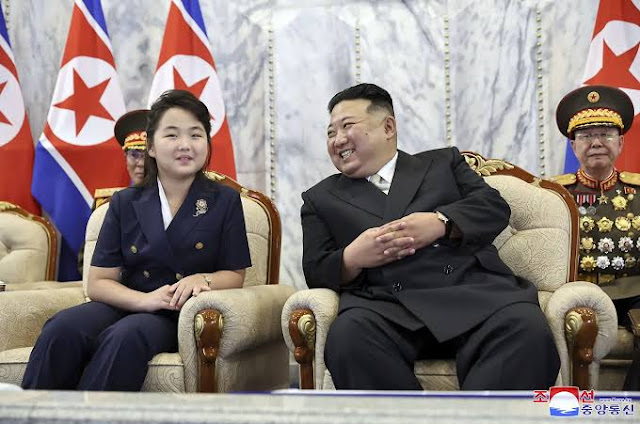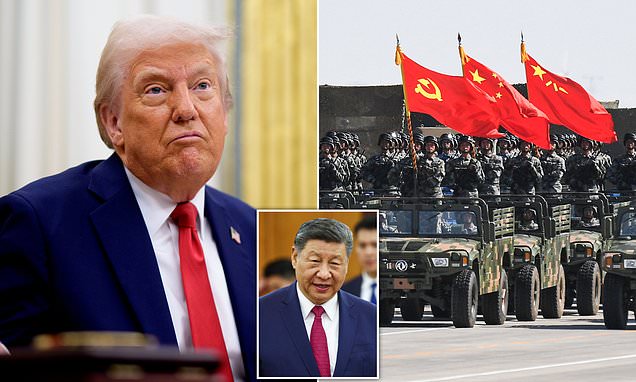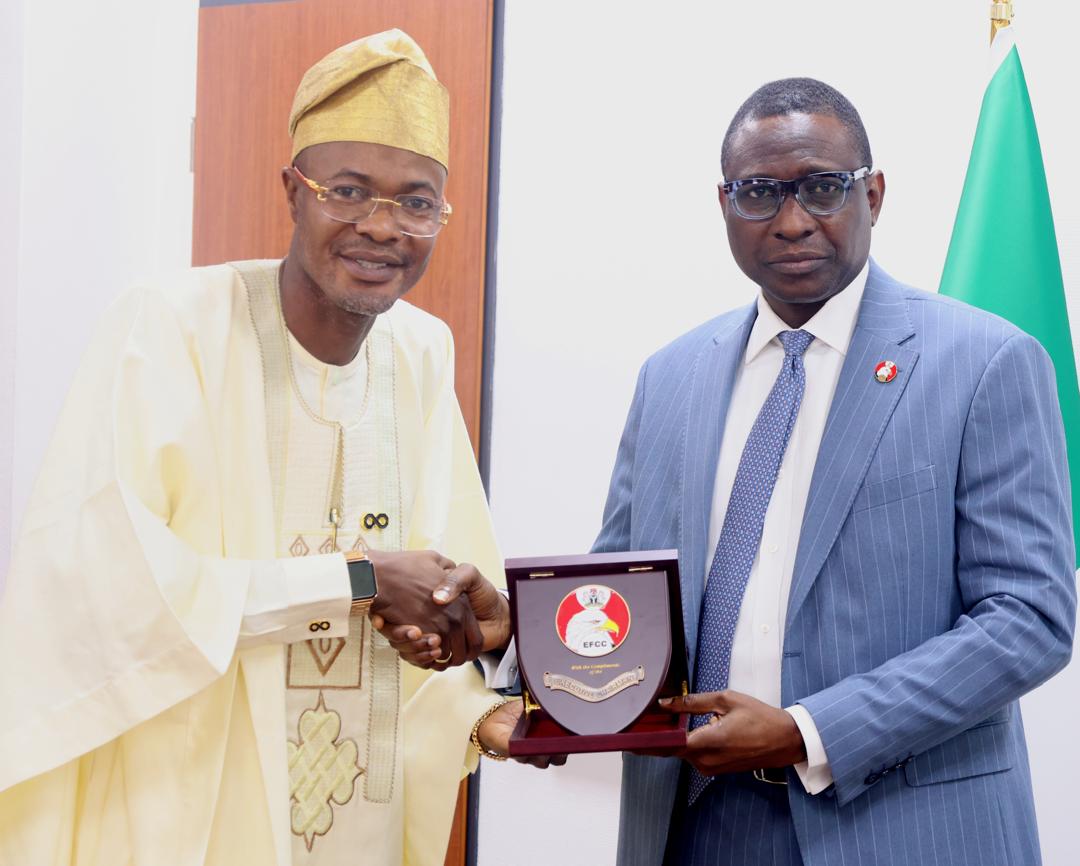On September 2, 2025, North Korean leader Kim Jong Un arrived in Beijing aboard his signature armored green train, a journey that marked his first visit to China since 2019. Accompanying him was a figure who drew significant attention: a young girl, believed to be his daughter, Kim Ju Ae, making her first public appearance outside North Korea. The occasion was China’s massive military parade on September 3, 2025, held in Tiananmen Square to commemorate the 80th anniversary of the victory in the Chinese People’s War of Resistance Against Japanese Aggression and the World Anti-Fascist War. Kim Ju Ae’s presence at this high-profile event sparked global speculation about her role, North Korea’s succession dynamics, and the broader geopolitical implications of the trip. This article delves into the details of the event, the significance of Kim Ju Ae’s appearance, the historical and political context, and the strategic messages conveyed by North Korea’s participation in the parade.
The Arrival: A Symbolic Journey
Kim Jong Un’s arrival in Beijing was a spectacle steeped in tradition and symbolism. The North Korean leader, known for his preference for rail travel due to security concerns, crossed the border into China on his heavily armored green train, a mode of transportation used by his father, Kim Jong Il, and grandfather, Kim Il Sung. The train, a relic of North Korea’s secretive and insular leadership style, is equipped with luxurious amenities and advanced security measures, reflecting the regime’s paranoia about external threats. According to North Korean state media, the Korean Central News Agency (KCNA), Kim and his entourage arrived in Beijing at around 4 p.m. local time on September 2, 2025, where they were warmly welcomed by senior Chinese officials, including Foreign Minister Wang Yi and Beijing Mayor Yin Yong.
As Kim disembarked, images captured a young girl walking behind him, dressed in a black outfit with her hair tied in a bow, smiling politely as she followed her father down a red carpet. This girl, widely believed to be Kim Ju Ae, became the focus of intense scrutiny. Her presence was not merely a familial gesture but a carefully orchestrated move by the North Korean regime, signaling potential shifts in its leadership narrative and international strategy. The parade, attended by other global leaders such as Russian President Vladimir Putin, provided a stage for Kim to project strength and unity, with his daughter’s appearance adding a layer of intrigue to the event.
Kim Ju Ae: The Mysterious Heir?
Kim Ju Ae’s public appearance in Beijing marked a significant milestone in her gradual introduction to the world stage. Little is known about her, and North Korea’s tightly controlled media has revealed scant details about her life. Her existence was first confirmed in 2013 when former American basketball star Dennis Rodman, after a visit to Pyongyang, mentioned that Kim Jong Un had a daughter named Ju Ae. Rodman’s revelation, shared in an interview with The Guardian, provided one of the few glimpses into the private life of North Korea’s ruling family. Estimates suggest that Ju Ae is now a preteen or early teen, though her exact age remains uncertain due to conflicting reports and the regime’s secrecy.
Since 2022, Ju Ae has appeared at several high-profile events in North Korea, primarily military-related, such as inspections of missile tests and military parades. These appearances, often alongside her father, have fueled speculation that Kim Jong Un is grooming her as a potential successor. In a country where the Kim dynasty has ruled since its founding in 1948, succession is a critical issue. Kim Jong Un, who assumed power in 2011 following the death of his father, Kim Jong Il, has relied on the cult of personality surrounding the Kim family to maintain control. Introducing Ju Ae to the public, both domestically and now internationally, suggests a deliberate effort to establish her as a figure of significance within this dynastic framework.
The Beijing trip, however, elevated Ju Ae’s visibility to a new level. Accompanying her father to a major international event attended by leaders like Xi Jinping and Vladimir Putin placed her in a context of global diplomacy. Observers noted that her presence was not accidental; it was a calculated move to signal continuity and stability in North Korea’s leadership. By presenting Ju Ae alongside autocratic allies, Kim Jong Un may be preparing her to navigate the complex alliances that sustain North Korea’s regime, particularly with China and Russia. Her polite demeanor and carefully curated appearance underscored the regime’s effort to portray her as a poised and capable figure, even at a young age.
The Beijing Parade: A Stage for Autocratic Unity
The military parade in Beijing was a grand affair, designed to showcase China’s military might and commemorate its historical victory over Japan in 1945. Held in Tiananmen Square, the event featured thousands of troops, advanced weaponry, and aerial displays, reinforcing China’s status as a global superpower. The presence of Kim Jong Un and Vladimir Putin, two of the world’s most prominent autocratic leaders, added a significant geopolitical dimension to the parade. The Chinese Foreign Ministry announced that 26 foreign heads of state and government attended, including Pakistan’s Prime Minister Shehbaz Sharif and Myanmar’s junta chief Min Aung Hlaing, but Kim and Putin were highlighted as the top guests, underscoring their strategic importance to China.
For Kim Jong Un, the parade was a rare opportunity to appear alongside other world leaders, given his limited international travel. Since assuming power in 2011, he has made only 10 foreign trips, with his last visit abroad in 2023 to meet Putin at a Russian spaceport. The Beijing trip, his first to China since 2019, highlighted the enduring alliance between North Korea and China, formalized by a mutual defense treaty signed in 1961. China has long been North Korea’s primary political and economic patron, providing a lifeline to its heavily sanctioned economy. The parade offered Kim a platform to reinforce this relationship while aligning with other leaders who share a vision of challenging Western-dominated global governance.
The image of Kim, Putin, and Xi standing together atop the Gate of Heavenly Peace was a powerful symbol of anti-Western unity. This “photo-op” was particularly significant given the geopolitical context: the United States, under a new administration following the 2024 election, was navigating a shifting global landscape, with President Donald Trump expressing interest in engaging with Kim Jong Un. Meanwhile, Russia’s ongoing war in Ukraine and China’s assertive posture in the South China Sea and Taiwan Strait have heightened tensions with the West. The parade, therefore, was not just a celebration of historical victory but a statement of solidarity among leaders who see themselves as counterweights to U.S. influence.
Geopolitical Context: North Korea’s Evolving Alliances
Kim Ju Ae’s appearance in Beijing must be understood within the broader context of North Korea’s foreign policy and alliances. In recent years, North Korea has deepened its ties with Russia, particularly since the onset of Russia’s war in Ukraine. In 2024, Kim and Putin signed a landmark defense pact in Pyongyang, pledging mutual military assistance in the event of an attack. This agreement, coupled with North Korea’s deployment of troops to support Russia’s war efforts, has alarmed the United States and its allies in Asia, including South Korea and Japan. A North Korean propaganda video released on August 31, 2025, praised its soldiers’ contributions to Russia’s campaign, portraying Kim as a strategic player in global conflicts.
China, while North Korea’s closest ally, has viewed this growing Russia-North Korea partnership with caution. Beijing values regional stability and has been wary of North Korea’s provocative actions, such as missile tests and nuclear rhetoric. However, the parade provided an opportunity for China to reaffirm its “traditional friendship” with North Korea, as noted by Assistant Foreign Minister Hong Lei. Xi Jinping’s warm reception of Kim, including a personal expression of hospitality, underscored the importance of this relationship, even as China navigates its own strategic priorities, such as energy cooperation with Russia and territorial disputes in the South China Sea.
Kim Ju Ae’s presence in Beijing may also reflect North Korea’s desire to signal continuity in its alliances. As a potential future leader, her exposure to China’s leadership and the dynamics of international diplomacy could prepare her for navigating these relationships. The parade, with its focus on anti-fascist solidarity and historical grievances against Japan, provided a fitting backdrop for reinforcing North Korea’s alignment with China and Russia, both of which share a narrative of resisting Western hegemony.
Succession and Domestic Politics
The question of succession is a perennial concern in North Korea, where the Kim family’s dynastic rule is central to the regime’s legitimacy. Kim Jong Un, who inherited power at a relatively young age, has faced health concerns and speculation about his longevity, prompting discussions about who might succeed him. His sister, Kim Yo Jong, has been a prominent figure in the regime, often acting as a spokesperson and wielding significant influence. However, Ju Ae’s recent appearances suggest that Kim Jong Un may be prioritizing a direct familial successor, consistent with the dynasty’s tradition.
Ju Ae’s role in Beijing was likely intended to signal stability to both domestic and international audiences. Within North Korea, her presence alongside her father reinforces the Kim family’s enduring authority, a message amplified by state media’s coverage of the trip. Internationally, it suggests that North Korea is planning for a long-term future under Kim family rule, potentially easing concerns among allies like China about political instability. However, her young age raises questions about how soon she could assume a leadership role and whether other figures, such as Kim Yo Jong, might serve as regents or interim leaders.
The decision to bring Ju Ae to Beijing also reflects Kim Jong Un’s confidence in his regime’s stability. North Korea’s economy, while heavily sanctioned, has benefited from Chinese support and illicit trade networks. Recent reports indicate that Kim has overseen a rapid modernization of North Korea’s military, including advancements in missile technology and serial production of various missiles. The Beijing trip, with its display of military and diplomatic alignment, underscores Kim’s ability to project power despite international isolation.
Historical and Cultural Significance
The choice of Beijing’s military parade as Ju Ae’s first international appearance was laden with historical and cultural significance. The event commemorated the 80th anniversary of Japan’s surrender in 1945, a victory that holds deep resonance in both China and North Korea. For North Korea, the war against Japanese aggression is a cornerstone of its national narrative, with the Kim family’s role in the resistance—particularly Kim Il Sung’s guerrilla campaigns—central to its legitimacy. By bringing Ju Ae to this event, Kim Jong Un linked her to this historical legacy, positioning her as a continuation of the family’s revolutionary heritage.
The parade also highlighted the shared history between China and North Korea, which fought together against Japan during the war. The 1961 mutual defense treaty, invoked during the parade’s rhetoric, remains a symbol of this bond. For Ju Ae, exposure to this narrative reinforces her understanding of North Korea’s place in the world and the importance of its alliances. Her presence alongside Xi Jinping and Putin further situates her within a lineage of leaders who see themselves as defenders of sovereignty against external pressures.
Global Reactions and Media Coverage
The international community closely watched Kim Ju Ae’s appearance, with media outlets offering varied interpretations. Western media, such as CNN and BBC, emphasized the succession angle, speculating about her potential role as North Korea’s future leader. Analysts noted that her presence in Beijing was a rare glimpse into North Korea’s opaque political system, with some suggesting it was a strategic move to normalize her image globally.
In China, state media portrayed the visit as a reaffirmation of the “traditional friendship” between Beijing and Pyongyang, focusing on the warm reception and historical ties. Russian media, meanwhile, highlighted the unity among anti-Western leaders, framing the parade as a counterpoint to U.S.-led alliances. South Korean and Japanese outlets expressed concern about North Korea’s growing ties with Russia and China, particularly in light of its military support for Russia’s war in Ukraine.
Social media platforms, including X, buzzed with discussions about Ju Ae’s appearance, with some users speculating about her age and role, while others focused on the symbolism of the armored train and the parade’s geopolitical implications. These reactions, while inconclusive, underscored the global fascination with North Korea’s secretive regime and the intrigue surrounding its next generation of leadership.
Implications for the Future
Kim Ju Ae’s trip to Beijing has far-reaching implications for North Korea’s domestic and international trajectory. Domestically, it strengthens the Kim family’s narrative of continuity and legitimacy, potentially preparing the public for a future under Ju Ae’s leadership. Internationally, it signals to allies like China and Russia that North Korea is planning for stability, even as it faces economic challenges and international sanctions.
The trip also reinforces North Korea’s alignment with anti-Western powers, a trend that has intensified in recent years. As the United States and its allies navigate a complex global landscape, Kim Jong Un’s strategic partnerships with Xi Jinping and Vladimir Putin position North Korea as a player in a broader geopolitical contest. Ju Ae’s exposure to this dynamic suggests that she is being groomed to navigate these alliances, potentially as a future leader who will maintain North Korea’s defiance against Western pressure.
For China, the parade and Kim’s visit were an opportunity to project strength and unity at a time of heightened geopolitical uncertainty. The presence of Ju Ae added a layer of intrigue, signaling that North Korea’s leadership is thinking long-term. For Russia, the event was a chance to deepen its partnership with North Korea, building on their recent defense pact and military cooperation.
Conclusion
Kim Jong Un’s trip to Beijing on September 2, 2025, accompanied by his daughter Kim Ju Ae, was a historic moment that captured global attention. Her first public international appearance, set against the backdrop of China’s grand military parade, was a carefully orchestrated move with profound implications. It signaled North Korea’s focus on dynastic succession, its strengthening ties with China and Russia, and its determination to project strength despite international isolation. For Kim Ju Ae, the trip was a debut on the world stage, introducing her to the complexities of global diplomacy and the alliances that sustain her country’s regime.
As the world watches North Korea’s next moves, Ju Ae’s role will remain a subject of fascination and speculation. Whether she is being groomed as a future leader or simply a symbolic figure, her presence in Beijing marked a new chapter in North Korea’s ongoing saga. The parade, with its display of military might and historical resonance, underscored the enduring power of the Kim dynasty and its place in a rapidly changing global order.









